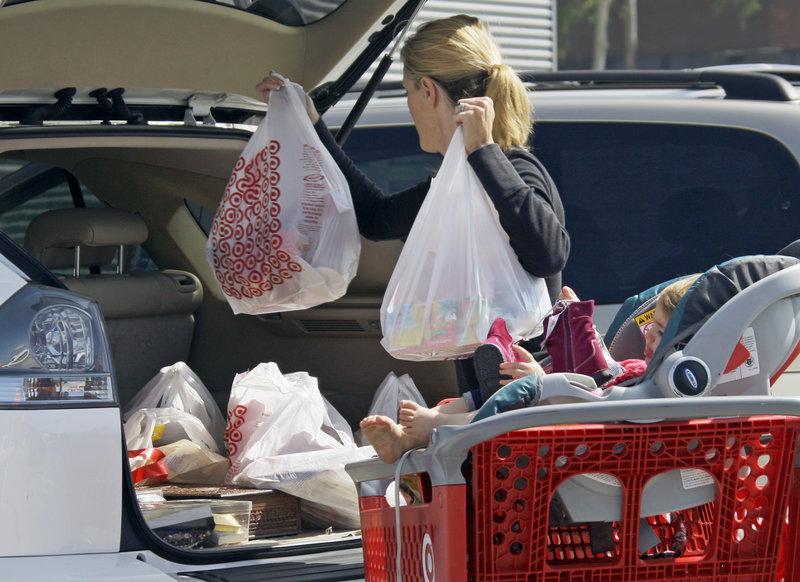Anyone counting on holiday shoppers to jolt the economy out of its doldrums may be in for a disappointment.
It’s not exactly a stocking full of coal, but the National Retail Federation is setting expectations low with its forecast for the all-important Christmas shopping season. The industry trade group said Wednesday that it expects a paltry 2.8 percent increase in holiday retail sales, to $465.6 billion, far below the 5.2 percent increase retailers experienced in 2010.
With the European debt crisis, the S&P 500-stock index nearing a bear market and weak U.S. economic growth, the season could be an important factor in whether businesses pull back and tip the country into another recession. Consumer spending accounts for roughly 70 percent of the overall economy, and the holiday season traditionally produces as much as 40 percent of all retail sales.
Would-be shoppers may remain on their couches this year amid sputtering job growth, higher gas and food prices and continued volatility in the stock market, said federation chief economist Jack Kleinhenz.
Still, he pointed out, “consumer confidence turned up a little bit last week. Retail sales … on a year-over-year basis have been growing. I don’t count the consumer out.”
Other economic indicators bode well for the coming season, he said, including a reduction in household debt and an increase in the use of credit cards.
Shoppers’ outlook for the holidays, despite intentions to spend less, remains better than it was coming out of the recession in 2009, according to a recent survey by the research firm Kantar Retail. Only 35 percent of the 4,004 people polled intended to spend much less this year, compared with 43 percent in 2009.
“The fact that spending intentions aren’t falling off as dramatically as consumer confidence does give us some hope the slowdown we expect for the holiday will not be as bad as the last recession,” said Frank Badillo, senior economist for Kantar Retail.
Kantar, like the National Retail Federation, expects retail sales in the fourth quarter to increase 2.8 percent. That lackluster prediction is on par with just about every forecast to trickle into the market in the past month.
The International Council of Shopping Centers, a New York-based trade group, expects a 2.2 percent gain in the last two months of the year, while ShopperTrak out of Chicago is placing bets on a 3 percent uptick in sales during that time.
Gauging consumer sentiment this early in the season is a bit of crapshoot, economists say. Another uptick in employment like the 91,000 new hires that ADP Employer Services tracked in September could buoy confidence and encourage consumers to spend. A surge in fuel and commodity prices or unemployment could result in the opposite.
Memories of the devastating sales of 2008, when holiday revenue fell 4.4 percent, have kept retailers fairly conservative in their planning for the season.
Lindsey Buscher of Urban Chic, a chain of women’s apparel and accessories boutiques in the Washington area, ordered a few more designer iPad holders and Shoshanna dresses this year, but kept a tight rein on inventory.
“We don’t over-buy anymore,” she said.
Margins for Buscher’s four stores were up 10 percent through the first seven months of the year, making her bullish about the holiday season, despite uncertainty in the financial markets.
Britt Beemer, chairman of consulting firm America’s Research Group, said he finds it telling that major retailer Wal-Mart is reinstating its layaway payment plan for the holidays after a four-year hiatus.
“Wal-Mart is probably the best barometer sometimes to measure what is going on in the country,” Beemer said. “They’ve told analysts on three different occasions that they’ve noticed a 20 percent drop in sales as consumers are running out of money by the end of each month.”
Send questions/comments to the editors.



Success. Please wait for the page to reload. If the page does not reload within 5 seconds, please refresh the page.
Enter your email and password to access comments.
Hi, to comment on stories you must . This profile is in addition to your subscription and website login.
Already have a commenting profile? .
Invalid username/password.
Please check your email to confirm and complete your registration.
Only subscribers are eligible to post comments. Please subscribe or login first for digital access. Here’s why.
Use the form below to reset your password. When you've submitted your account email, we will send an email with a reset code.